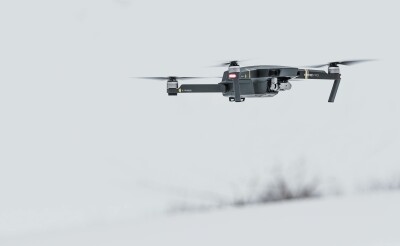As the only pan-European event for professionals responsible for RPAS integration and operation within their enterprise, Commercial UAV Europe is set to showcase key insights around what it means to utilize drone technology to make entire processes faster, cheaper or safer. Taking place in Amsterdam on April 10-12, the event will pull together experts from across the world to talk through topics like storing and sharing UAV data, how to calculate the ROI of your UAV program, where things are going with U Space and plenty more.
Keynotes for the 2018 event have been announced, one of which will be delivered by Kay Wackwitz from Drone Industry Insights. We’ve talked with Kay in the past to get a better understanding of the commercial drone market in Europe and also to find out what the various partnerships that are being formed will mean for users and even the industry as a whole, but these are just a couple of the topics his Commercial UAV Europe keynote is set to explore.We connected with Kay to learn more about what he’s set to talk through in-depth during his 2018 presentation, Securing the Digital Transformation: The Layer-Cake of Drone Data Protection. We asked him about drone hardware commoditization, efforts to properly integrate data into a workflow, what role counter-drone technology will play this year and plenty more.To register for Commercial UAV Europe, click here. Jeremiah Karpowicz: Your partner Hendrik delivered one of the keynote presentations at Commercial UAV Europe last year, and he mentioned that your firm had seen a big swing in VC funding from hardware to software. Is that a trend that you see continuing in 2018?Kay Wackwitz: What we’ve seen is that hardware is still playing an important role when it comes to saving process time and costs. Many companies realized that hardware can be an important enabler for even more productivity in the workflow. The initial swing towards software was triggered by the urge to create an ecosystem around the hardware so that drones could perform critical tasks. That includes things like flight-planning, analytics software, etc.Numerous tools to create 3D models from point clouds are available today, but they only cover the surveying part of industrial applications. AI and deep learning software are making their way into the drone space to enable not just automated data acquisition by drone, but also automated data analytics. We are currently working on an update of our investment report to describe these trends more in detail. Does this swing mean 2018 will be the year when drone hardware will truly become commoditized? I don’t think we’re there yet in the commercial sector. Commodity requires a certain rate of adoption throughout an industry, and I don’t see that happening anywhere at scale. Once gigantic drone fleets operate in fully digitalized workflows, I'll be ready to call the technology commoditized, but I don’t see that happening in 2018. Regulation is a key concern for organization across the continent, but what kind of issues do you think could arise for anyone who wants to wait until 2019 to fully explore drone technology, which is when regulatory framework unifying all European countries is set to come out? When it comes to commercial drone adoption, you’ve only got two choices: disrupt or be disrupted.Being an early adopter pays off, especially when it comes to drone technology. The rate of technological improvements is massive and the longer you wait the harder it gets to be a relevant player in this game.As a brief example of that, let’s say you’re a surveying company that’s aware of the benefits of drone technology, but you decide that you want to wait until a “complete drone solution” is available and the regulatory framework is set. What’s going to happen to you when that regulatory framework opens things up and you decide it’s time to move forward with drone adoption?First of all, your company will have missed out on all the savings the technology could have provided you with for the past few years. Secondly, this process is going to require a massive in-house reorganization, and that could mean moving from an analogue to an entirely digital workflow. Perhaps mostly importantly though, waiting doesn’t guarantee anything about how the technology or regulation will change. The European airspace will not be unified by 2019. In two years, there will still be country-specific differences within Europe.If you start this process today, things will be that much easier and better for you down the road, regardless of what does or doesn’t change with the technology and the regulatory environment. With all the talk last year of “data being the new oil,” it feels like more organizations have caught onto the importance of workflow-integration. Would you say that’s the case or not? Digitalization footprints within companies of all sizes are definitely getting bigger and more people really do understand the importance of data. However, oil is only valuable if you’re able to exploit it. If you haven’t setup an infrastructure or ecosystem for the oil you’re extracting, it’s worthless. It’s the same thing with data.No one needs a centimeter-accuracy map of a field if there aren’t any devices to use this data, unless you’re doing something like spraying pesticides according to a spray pattern in centimeter-accuracy. Turning data into actionable information will remain the major challenge for a long time since it requires a lot of digitalized equipment doing real work.Companies like Airbus Aerial and Intel Insights are working to create and provide data platforms to serve as a launching pad for companies that have or are gathering this data, and that approach can help organizations focus on what it will mean to see data transition into actionable information. When it comes to workflow integration though, the devil is always in the detail. It will take companies a long time to fully use the potential of these platforms in their very specific workflow. Your keynote presentation is set to focus on what we’ll be seeing with the drone market in Europe, but will there be anything about counter drone technology, which you’ve already identified as having the potential to impact the 2018 drone market in a big way?The counter drone market is definitely something I plan to discuss, because there’s a lot happening there. Numerous investments in this space underscore the importance of drone defense systems, as the potential to create harm with warfare techniques in a civilized world is enormous.One thing I want to make sure everyone understands is that today, flying a drone is easy. Drone defense is much harder, because that system is only as strong as its weakest link. Flying a big drone with a person in it means you have to make sure there are no weak links in that system at all, and that is of course an especially hard problem to solve. Tell us about some of the other key topics or trends you plan to explore in-depth during your keynote.Data security, mobility concepts and the combination of both are a few of the other areas I plan to detail. Much of that is related to what kinds of devices are going to be operating in the airspace, and that’s part of the reason the potential of 3rd dimension travel so inspiring. New concepts around flying cars and aerial taxis are popping up on a weekly basis.There are also some bigger trends that I want to touch on with larger companies grabbing the best pieces of a given organization or technology before it’s too late. That’s something you can see with developments like Terrafugia being acquired by Volvo-owner Geely, and Aurora Flight Sciences being acquired by Boeing.All of it is really about making sure air travel is safe no matter what you’re flying. It’s the same principle regardless of whether we’re talking about a regular airliner or an electric helicopter. It’s a big challenge, and the increasing connectivity and degree of automation does not necessarily help, since that kind of automation could potentially mean we have that many more weak links in the ecosystem. There’s huge potential with them though, and it’s the reason I sincerely hope and believe these technologies will have a big and positive impact on the unmanned systems market in 2018.
Tell us about some of the other key topics or trends you plan to explore in-depth during your keynote.Data security, mobility concepts and the combination of both are a few of the other areas I plan to detail. Much of that is related to what kinds of devices are going to be operating in the airspace, and that’s part of the reason the potential of 3rd dimension travel so inspiring. New concepts around flying cars and aerial taxis are popping up on a weekly basis.There are also some bigger trends that I want to touch on with larger companies grabbing the best pieces of a given organization or technology before it’s too late. That’s something you can see with developments like Terrafugia being acquired by Volvo-owner Geely, and Aurora Flight Sciences being acquired by Boeing.All of it is really about making sure air travel is safe no matter what you’re flying. It’s the same principle regardless of whether we’re talking about a regular airliner or an electric helicopter. It’s a big challenge, and the increasing connectivity and degree of automation does not necessarily help, since that kind of automation could potentially mean we have that many more weak links in the ecosystem. There’s huge potential with them though, and it’s the reason I sincerely hope and believe these technologies will have a big and positive impact on the unmanned systems market in 2018. 














Comments